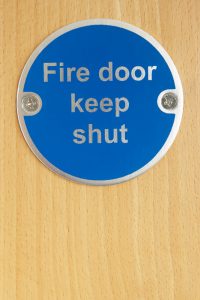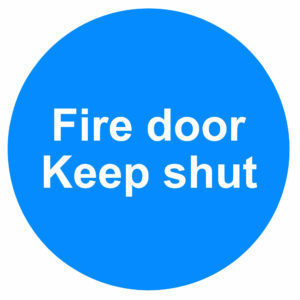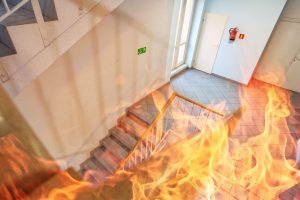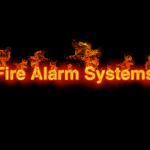Between 2016 and 2017, the UK reported around 15,815 fires in non-residential properties. The damage caused was limited to a maximum of two floors in 9,000 of these fire occurrences. Damage to the entire building was sustained in just over 2,500 of these cases. The use of fire doors was one of the main reasons behind the decrease in damage resulting from such occurrences.
Property owners are legally required to install the fire doors in all buildings, except private homes, according to The Regulatory Reform (Fire Safety) Order 2005 (RRO). The installation of fire doors must be conducted by a competent person. The act defines such a person as one with the necessary knowledge, qualifications, training and experience needed to implement fire safety measures in a building structure.
Fire doors in most of the buildings in the United Kingdom lack in some way, with an average of four issues discovered in each of the doors inspected, according to a report published by the FDIS (Fire Door Inspection Scheme). The report compiled the findings of a mass fire door inspection exercise conducted back in 2014. Use of the wrong hinges, missing signs and defective smoke seals were among the commonly cited issues.
The failure of a fire door, which ends up exposing human beings and property to fire related risks, can occur in less than five minutes if the door is not properly fitted.
Contents
- 1 What Are Fire Doors?
- 2 What Is The Difference Between A Regular Door and A Fire Door?
- 3 How Do You Identify A Fire Door?
- 4 What Are The Different Types Of Fire Doors?
- 5 What Are Fire Door Ratings?
- 6 What Are Fire Door Regulations?
- 7 What Are The Internal And External Fire Door Regulations?
- 8 What Are The Fire Door Requirements For Domestic Vs. Non-Domestic Buildings?
- 9 What Are The Regulations For Installing Fire Doors?
- 10 What Are Fire Door Frame Regulations?
- 11 What Are The Fire Door Maintenance Regulations?
- 12 What Are The British Standards For Fire Doors?
- 13 What Are The Differences Between Fire Exit Doors And Fire Doors?
- 14 Conclusion
What Are Fire Doors?
When a fire door is installed correctly and utilised, it can help limit the spread of fires inside buildings, providing occupants with the chance to exit the structure and firefighters to arrive at the scene and combat the fire and even save the building.
A fire door can keep a fire at bay for at least half an hour if it is made by a manufacturer certified by the British Woodworking Federation (BWF), using compatible components and received accredited third-party certification.
What Is The Difference Between A Regular Door and A Fire Door?
 Fire doors are primarily designed to keep smoke, heat, and flames of a fire at bay, unlike regular doors mainly designed to separate rooms and enhance security by limiting access or sound insulation.
Fire doors are primarily designed to keep smoke, heat, and flames of a fire at bay, unlike regular doors mainly designed to separate rooms and enhance security by limiting access or sound insulation.
To demonstrate its effectiveness in slowing down or preventing the spread of smoke and fire within a building, a fire door comes with a fire resistance rating.
How Do You Identify A Fire Door?
There are many ways of identifying a fire door, with the simplest one being the necessary signage. You will find the words Fire Door Keep Shut written in white on a blue sticker on fire doors.
Closing mechanisms, gaps, seals and hinges are some of the other distinguishing features of a fire door.
Gaps on the sides and tops of the fire door should have a maximum width of four millimetres.
There should be a thin seal (intumescent) running down the middle visible on the door frame and door profile. To completely close the gap between the door and the frame during a fire, the seal should be sensitive to heat – and thus swell when exposed to relatively high temperatures.
At the very least, three millimetre hinges should be used.
Last but not least, the fire door should be capable of closing itself, without sticking, when opened halfway, when equipped with the right closing mechanism.
What Are The Different Types Of Fire Doors?
Double Fire Doors
For a fire door to be compliant with British Standard 8214:2008, the space between the leaves of a double door as well as the top and sides should be approximately 3 millimetres, give or take one millimetre. Double doors are an excellent fit for building with a higher number of occupants or wider door openings.
Glass Fire Doors
For internal doors that comply with all the necessary fire safety regulations, pyropanel glass fire doors are increasingly seen as a better looking alternative to the traditionally popular wooden and steel fire doors.
Fire rated glass must be used on all pyropanel fire doors. To prevent the spread of smoke and flames, fire rated glass has been tested and approved as an effective barrier.
It is also possible to prevent the spread of heat with some types of fire rated glass. While ordinary glass cannot stand up to temperatures over 120 degrees Centigrade, fire rated glass can survive temperatures exceeding 900 degrees Centigrade.
It is important for your fire door(s) to comply with the applicable fire safety guidelines, especially given that building fires normally burn hotter than 600 degrees Centigrade.
Pre-hung Fire Doors
In a new build or large construction, pre-hung fire doors can be used to save money and time. A single package made up of various components, including the architraves, frame and leaf, is supplied ready for installation when ordering pre-hung fire doors.
Pre-hung fire doors are installed once all of the construction work is complete to decrease any risk of damage to the door, which would render it non-compliant with the applicable fire safety regulations.
Steel Fire Doors
While glass or wooden fire doors are known to provide around 30 to 60 minutes of fire protection on average, steel fire doors can extend this time to up to four hours. Using the testing guidelines outlined in British Standard EN 1634-1:2014 or British Standard 476-22:1987, the standard of fire protection provided will be specified.
Thanks to their durable and strong nature, these fire doors may be preferred over other available options when enhanced security is required.
In applications where higher levels of hygiene are necessary, such as hospitals and kitchens, among others, steel fire doors are also preferred as they are easy to clean.
Wooden Fire Doors
Particleboard, flaxboard, timber or magboard are some of the different materials used to make the solid core found in most wooden fire doors. A lipping around the core with a veneer finish, MDF or plywood glued to the core or a timber frame with a laminated outer finish are some of the different ways in which the core is finished. Provided that the necessary fire rating is met, any of these finishing methods can be used.
It is worth noting that you should always remember to use fire retardant paint if you plan on painting a fire door made of wood.
What Are Fire Door Ratings?
The FD rating assigned to fire doors is dependent on the amount of time it can stand up to fire. To put this into perspective, fire doors providing 60 minutes and 30 minutes of protection have an FD60 and FD30 rating. FD ratings are assigned after stress testing as per the guidelines laid out in BS 476 part 22:1987.
Some of the commonly seen ratings include:
- FD30: 30 minutes of protection
- FD60: 60 minutes of protection
- FD90: 90 minutes of protection
- FD120: 120 minutes of protection
What Are Fire Door Regulations?
 The Fire Safety Order (RRO) 2005 lays out the fire door regulations for all existing building structures with the exception of domestic buildings.
The Fire Safety Order (RRO) 2005 lays out the fire door regulations for all existing building structures with the exception of domestic buildings.
When the extension or building is occupied for the first time, or the project is completed, the responsible person must be furnished with all the necessary fire safety information. This is in accordance to Regulations 38 of the Building Regulations – applicable in England and Wales – which ties the Building Regulations to the Fire Safety Order.
What Are The Internal And External Fire Door Regulations?
In the event of a fire, internal fire doors are meant to divide the building into separate compartments. This way, for the amount of time indicated by the FD rating of the doors, occupants have a protected way out of the building or space. On the other hand, external fire doors are situated at the end of the exit route; and, as such, are not required to remain closed or even be fire resistant.
Such external doors can be categorised as fire doors provided that they always remain clear and satisfy the necessary fire door regulations, such as having a means of opening from the inside and the applicable labelling.
What Are The Fire Door Requirements For Domestic Vs. Non-Domestic Buildings?
According to the applicable guidelines, buildings must be partitioned into separate compartments/spaces to protect exit routes like staircases and hallways.
Domestic Properties
At all levels, each stairwell door must be a fire door, leading to a safe room in domestic buildings with more than two levels. Furthermore, in a mixed-use building, fire doors are required between the residential and the business spaces; and between the integral garage and house in the case of loft conversions.
Non-Domestic/Commercial Buildings
The guidelines are categorised into two separate sections, based on vertical and horizontal escape routes, when it comes to commercial and non-domestic properties. The process of evacuating all occupants of a building with multiple levels using a flight of stairs is referred to as vertical evacuation. On the other hand, occupants move horizontally, into a fireproof compartment or space, on the same level/floor, to get away from the fire, in horizontal evacuation.
While the decision between horizontal and vertical evacuation is made independently, per building, the safety and speed of each option when it comes to the evacuation of a building’s occupants is the main determining factor; with vertical evacuation being the best fit in most cases.
According to the Fire Safety Order 2005, this route must be lined with fire doors at the very least. The door’s surroundings, location, and building type are all considered in an independent evaluation used to determine the most suitable FD rating of the fire doors to be installed.
In accordance with Article 3 of the 2005 Fire Safety Order, the installation of fire doors in a commercial building is the duty of a “responsible person”. This can be any of the following:
- A self-employed individual or employer with a commercial building
- Volunteer or Charity organisation
- Contractor in charge of any building
- Individual offering to accommodate guests in exchange for payment
What Are The Regulations For Installing Fire Doors?
The law does not mention any specific accreditation or qualification requirements for those handling the installation of fire doors. But, it is essential that this undertaking be left in the hands of a seasoned and reputable expert given the fact that the smallest issue, be it a crack or gap between the seal, glasswork, or door and the frame can translate into a defective fire door that does not satisfy the safety requirements set out in the RRO.
What Are Fire Door Frame Regulations?
 One of the main components of any fire door is the frame on which it’s hung. When buying a fire door frame, it is essential that you do so through a British Woodworking Federation approved seller or from a licensed fire door frame manufacturer or the manufacturer of the accompanying fire door.
One of the main components of any fire door is the frame on which it’s hung. When buying a fire door frame, it is essential that you do so through a British Woodworking Federation approved seller or from a licensed fire door frame manufacturer or the manufacturer of the accompanying fire door.
In some cases, it is not possible to install a new frame. Installing intumescent seals around the edge of the door is one of the practical solutions in such cases. Remember that there should be no more than 4 millimetres of space separating the door from the frame.
What Are The Fire Door Maintenance Regulations?
To make sure that fire doors are fully operational if and when the need to use them, they must be maintained and inspected regularly. Generally, inspections should be conducted bi-annually, with more checks being needed for doors deemed to be prone to damage due to regular use in high traffic areas. Preferably, these inspections should be conducted by an FDIS registered inspector. The knowledge and skills of these inspectors have been evaluated independently, as they have attained a diploma in fire doors.
What Are The British Standards For Fire Doors?
By asserting that fire doors should provide the same level of fire protection as the fixed components of a building, British Standard 8214 addresses the maintenance, installation and specification of fire doors.
Since the effectiveness of items like Door Hold Open Devices attached to fire doors is assessed as per the provisions of British Standard 5839-1:2013, the same standard should guide the installation of such items.
Fire safety practices for building use, management and design are laid out in British Standard 9999:2008. This standard can also be applied when reviewing changes or additions to an existing structure, structures under construction and existing structures. When it comes to ensuring that the fire safety of a building holds up, this standard can be a great evaluation tool.
What Are The Differences Between Fire Exit Doors And Fire Doors?
Basically, fire exit doors are designed with push bar handles. Many external fire doors are actually not fire doors. A collection of fire exit guidelines govern these doors. When using a building in ordinary circumstances, fire exits can be used as regular doors.
Conclusion
Properly installed and functioning fire doors play an essential role in ensuring the safety of a building’s occupants in case of a fire emergency.
By preventing the spread of smoke, heat and flames from one part of the building to another, these important structures also help minimise damage during a fire.
The UK government has enacted various fire safety laws and regulations designed to ensure that fire safety doors are installed in applicable buildings. The selection/purchase, installation, inspection and maintenance of all fire doors must be conducted in line with the applicable guidelines.
By following all the applicable regulations to the letter, you can be sure that your fire doors will work perfectly if, and when, called upon in the unfortunate event of a fire in your building.




